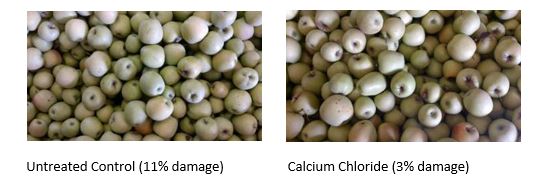Orchard Management
Cultural practices in orchards with a history of bitter pit may be modified to minimize this disorder. Consider the following factors.
Nutritional Factors
Ca nutrition is directly involved in bitter pit development and is discussed later in this factsheet. Other nutrients interact with Ca within the fruit. Upset nutrient balances can result in more serious bitter pit problems.
For example, excessive N causes large fruit that results in a dilution of Ca in the fruit and more serious bitter pit. N fertilizer should be applied based on leaf analysis. Excessive N is also indicated by excessive growth and large dark leaves.
Excessive K fertilizer applications can also depress Ca in the fruit, particularly when Ca levels are low. Apply K fertilizer only when leaf analysis indicates a need.
Boron (B) is involved in movement of Ca to the fruit. If B is low, Ca disorders such as bitter pit may develop. Be sure there is an adequate B level in the leaves by leaf analysis.
Pruning can result in higher N levels. If trees are to be severely pruned, reduce the amount of N fertilizer. Moderate annual pruning is best.
Mulch will even-out soil moisture fluctuations, helping to avoid bitter pit. Do not use mulch materials high in N, such as legume hay. A wide herbicide band with the sod herbicide system of soil management may lead to excessive N and more serious bitter pit problems. The herbicide strip should not extend beyond the spread of the tree branches.
Excessive fruit thinning or light crops result in large fruit. Annual cropping should be promoted by proper thinning. Apply Ca sprays when the crop is light or the fruit is large.
Since the disorder develops in storage, loss can be reduced by immediately marketing large fruit or fruit from areas where bitter pit has been a problem.
Chemical Control
It is now common practice in Australia to apply foliar sprays of calcium during the growing season. Because calcium does not move quickly in the plant, good coverage spray is essential. Calcium is applied multiple times from November through to March.
Regular applications are important to top up the cells with calcium as they expand. The key points for calcium spraying are (Rainham, 2016):
- Aim for at least 25kg of calcium/ha for pit sensitive varieties.
- Split into 20 sprays over the season.
- Make sure each application uses the full recommended rates.
- Keep the program going regularly right up to just before harvest. Late calcium applications are just as important as early applications.
- Every calcium application is important as it just tops levels up a little more.
- Apply to get best absorption, higher water volume sprays are better.
- Use buffered formulations especially in hot climates.
According to trials conducted by Fruit Growers Victoria in the season 2015/2016, Calcium Chloride has been applied 7 times on Golden Delicious in the rate of 10 L/Ha and results have been compared with untreated control.
When the fruit was taken out of the cool room, bins with apples treated with Calcium Chloride had only 3% of fruits affected by bitter pit compared to 11% of affected fruits on untreated control.
References:
- D. Rainham (2016): Calcium to combat post-harvest disorders; AgFirst New Zealand
- E. Hoover (2012); Bitter Pit and Calcium Deficiencies in Apple Fruit; University of Minnesota, USA
- J. Cline (2009): Bitter Pit Control in Apples, Factsheet, University of Guelph, USA
- J. A. Dart (2004); Bitter Pit in Apples; AgFact H4.AC.1 Second Edition, NSW Department of Primary Industries


